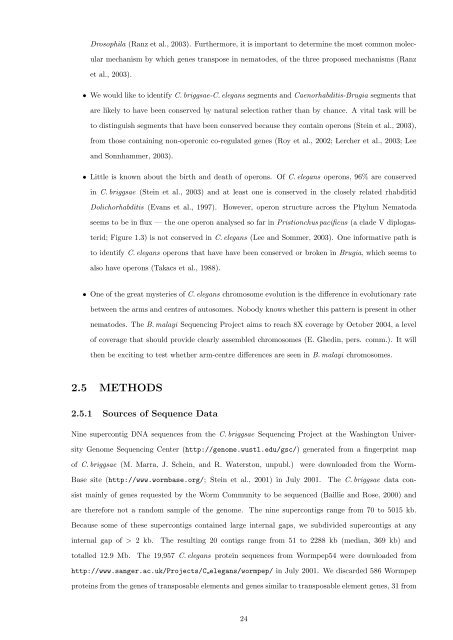Evolution of the genomes of two nematodes in the ... - Ken Wolfe
Evolution of the genomes of two nematodes in the ... - Ken Wolfe
Evolution of the genomes of two nematodes in the ... - Ken Wolfe
Create successful ePaper yourself
Turn your PDF publications into a flip-book with our unique Google optimized e-Paper software.
Drosophila (Ranz et al., 2003). Fur<strong>the</strong>rmore, it is important to determ<strong>in</strong>e <strong>the</strong> most common molec-<br />
ular mechanism by which genes transpose <strong>in</strong> <strong>nematodes</strong>, <strong>of</strong> <strong>the</strong> three proposed mechanisms (Ranz<br />
et al., 2003).<br />
• We would like to identify C. briggsae-C. elegans segments and Caenorhabditis-Brugia segments that<br />
are likely to have been conserved by natural selection ra<strong>the</strong>r than by chance. A vital task will be<br />
to dist<strong>in</strong>guish segments that have been conserved because <strong>the</strong>y conta<strong>in</strong> operons (Ste<strong>in</strong> et al., 2003),<br />
from those conta<strong>in</strong><strong>in</strong>g non-operonic co-regulated genes (Roy et al., 2002; Lercher et al., 2003; Lee<br />
and Sonnhammer, 2003).<br />
• Little is known about <strong>the</strong> birth and death <strong>of</strong> operons. Of C. elegans operons, 96% are conserved<br />
<strong>in</strong> C. briggsae (Ste<strong>in</strong> et al., 2003) and at least one is conserved <strong>in</strong> <strong>the</strong> closely related rhabditid<br />
Dolichorhabditis (Evans et al., 1997). However, operon structure across <strong>the</strong> Phylum Nematoda<br />
seems to be <strong>in</strong> flux — <strong>the</strong> one operon analysed so far <strong>in</strong> Pristionchus pacificus (a clade V diplogas-<br />
terid; Figure 1.3) is not conserved <strong>in</strong> C. elegans (Lee and Sommer, 2003). One <strong>in</strong>formative path is<br />
to identify C. elegans operons that have have been conserved or broken <strong>in</strong> Brugia, which seems to<br />
also have operons (Takacs et al., 1988).<br />
• One <strong>of</strong> <strong>the</strong> great mysteries <strong>of</strong> C. elegans chromosome evolution is <strong>the</strong> difference <strong>in</strong> evolutionary rate<br />
between <strong>the</strong> arms and centres <strong>of</strong> autosomes. Nobody knows whe<strong>the</strong>r this pattern is present <strong>in</strong> o<strong>the</strong>r<br />
<strong>nematodes</strong>. The B. malayi Sequenc<strong>in</strong>g Project aims to reach 8X coverage by October 2004, a level<br />
<strong>of</strong> coverage that should provide clearly assembled chromosomes (E. Ghed<strong>in</strong>, pers. comm.). It will<br />
<strong>the</strong>n be excit<strong>in</strong>g to test whe<strong>the</strong>r arm-centre differences are seen <strong>in</strong> B. malayi chromosomes.<br />
2.5 METHODS<br />
2.5.1 Sources <strong>of</strong> Sequence Data<br />
N<strong>in</strong>e supercontig DNA sequences from <strong>the</strong> C. briggsae Sequenc<strong>in</strong>g Project at <strong>the</strong> Wash<strong>in</strong>gton Univer-<br />
sity Genome Sequenc<strong>in</strong>g Center (http://genome.wustl.edu/gsc/) generated from a f<strong>in</strong>gerpr<strong>in</strong>t map<br />
<strong>of</strong> C. briggsae (M. Marra, J. Sche<strong>in</strong>, and R. Waterston, unpubl.) were downloaded from <strong>the</strong> Worm-<br />
Base site (http://www.wormbase.org/; Ste<strong>in</strong> et al., 2001) <strong>in</strong> July 2001. The C. briggsae data con-<br />
sist ma<strong>in</strong>ly <strong>of</strong> genes requested by <strong>the</strong> Worm Community to be sequenced (Baillie and Rose, 2000) and<br />
are <strong>the</strong>refore not a random sample <strong>of</strong> <strong>the</strong> genome. The n<strong>in</strong>e supercontigs range from 70 to 5015 kb.<br />
Because some <strong>of</strong> <strong>the</strong>se supercontigs conta<strong>in</strong>ed large <strong>in</strong>ternal gaps, we subdivided supercontigs at any<br />
<strong>in</strong>ternal gap <strong>of</strong> > 2 kb. The result<strong>in</strong>g 20 contigs range from 51 to 2288 kb (median, 369 kb) and<br />
totalled 12.9 Mb. The 19,957 C. elegans prote<strong>in</strong> sequences from Wormpep54 were downloaded from<br />
http://www.sanger.ac.uk/Projects/C elegans/wormpep/ <strong>in</strong> July 2001. We discarded 586 Wormpep<br />
prote<strong>in</strong>s from <strong>the</strong> genes <strong>of</strong> transposable elements and genes similar to transposable element genes, 31 from<br />
24


